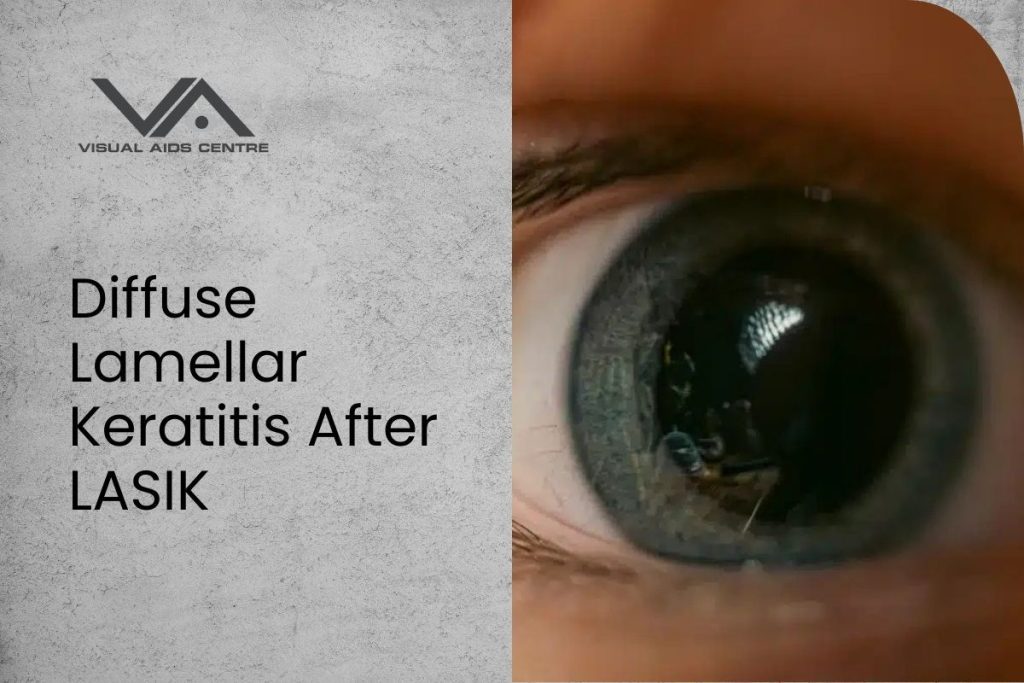Table of Contents
Toggle
About 1 in 5,000 people get a rare but serious problem called Diffuse Lamellar Keratitis (DLK) after LASIK. This issue causes inflammation under the corneal flap, leading to blurry vision, eye pain, and light sensitivity. Knowing about DLK is key for those thinking about LASIK or who have already had it.
DLK happens when inflammatory cells build up between the corneal flap and the stromal bed. Quick diagnosis and treatment are vital to avoid vision problems and possible permanent vision loss. Being informed about DLK helps patients navigate their LASIK journey and talk to their healthcare provider about any worries.
Understanding Diffuse Lamellar Keratitis
Diffuse Lamellar Keratitis (DLK) is a rare complication after LASIK. It’s when inflammatory cells gather under the corneal flap. This can cause vision problems and, if severe, permanent vision damage.
The exact cause of DLK is not fully known. But it’s thought to be caused by foreign particles or inflammatory substances getting into the space between the corneal flap and the stromal bed during or after LASIK. Debris from surgical tools or contaminants might contribute to DLK.
Knowing about DLK is important for both patients and surgeons. It helps prevent and manage the condition. By understanding the causes and risk factors of DLK, patients can be better prepared for the possible complications of LASIK surgery.
Recognizing the Symptoms of DLK
Knowing the signs of DLK after LASIK is key to better treatment outcomes. DLK is an inflammation in the cornea after LASIK surgery.
Early Detection
Spotting DLK early is critical for effective management and preventing long-term vision issues. Symptoms usually start within a few days to a week after LASIK.
Common symptoms include blurry or hazy vision, which can affect daily life. Sensitivity to light, or photophobia, makes it hard to be in bright places.
Mild eye discomfort or pain, redness, or inflammation, and excessive tearing are also signs of DLK. These symptoms can vary in severity and should be reported to the surgeon quickly.
It’s important for patients to watch their eye health after LASIK and seek medical help if they notice unusual symptoms. Early action can greatly improve outcomes and reduce the risk of complications.
Common Causes and Risk Factors for DLK
DLK, a possible complication of LASIK, can be caused by various factors. Knowing these causes and risk factors is key for both surgeons and patients to prevent and manage DLK effectively.
One main cause of DLK is debris or contaminants during LASIK. This can happen due to non-sterile instruments or foreign particles in the surgical area. Keeping the environment sterile and using advanced tools can lower this risk.
Pre-existing inflammatory conditions in patients are another big risk factor for DLK. Conditions like blepharitis or meibomian gland dysfunction can increase DLK risk after LASIK. Managing these conditions before LASIK is important.
Surgical Techniques and Instruments
The LASIK technique and tools used can also affect DLK risk. For example, certain microkeratomes or femtosecond lasers might increase DLK risk. Surgeons should pick the best techniques and tools for each patient.
Patient-Related Factors
Patient factors, like allergies and pre-existing ocular surface diseases, can also impact DLK risk. Patients with allergies or conditions like dry eye may be at higher risk. Identifying these factors before surgery can help in taking preventive steps.
Understanding DLK’s causes and risk factors helps patients decide on LASIK surgery. It also helps surgeons manage DLK if it happens, improving surgery results.
How DLK is Diagnosed After LASIK
A DLK diagnosis comes from a detailed eye exam with advanced tools. It’s key for managing and treating DLK after LASIK.
The exam uses a slit-lamp microscope to see inflammatory cells under the corneal flap. This is a key sign of DLK.
Other tools like confocal microscopy or OCT might also be used. They help see how bad DLK is, guiding treatment.
These tools help doctors track DLK and adjust treatment plans. Accurate diagnosis means better treatment for DLK.
The Four Stages of Diffuse Lamellar Keratitis After LASIK
DLK after LASIK is divided into four stages. Each stage shows how severe the inflammation is. Knowing this helps doctors choose the right treatment.
The stages are:
- Stage 1: Peripheral inflammation with little effect on vision.
- Stage 2: Inflammation moves to the cornea’s center, affecting vision.
- Stage 3: Dense inflammation in the center, badly affecting vision.
- Stage 4: Serious inflammation leading to scarring and vision loss.
Knowing these stages helps patients and doctors understand DLK’s severity. This helps in choosing the best treatment, improving recovery chances. Understanding DLK’s stages helps patients make informed decisions. It also helps doctors manage DLK better, guiding patients.
Treatment Options for DLK
DLK treatment includes many options, from eye drops to surgery. The main treatment is corticosteroid eye drops to reduce inflammation. The type and frequency of corticosteroids depend on DLK’s severity. Mild cases might just need eye drops. But severe cases need more.
For severe DLK, surgery might be needed. This involves lifting the flap and cleaning out inflammatory cells. Treatment choices depend on DLK’s stage and how well the patient responds to treatment. The goal of treatment is to reduce inflammation and protect vision. Tailoring treatment to each case helps manage DLK well, improving LASIK surgery outcomes.
Step-by-Step Guide to Managing DLK at Home
Managing DLK at home needs careful attention to your surgeon’s instructions. It also involves a few simple steps. While medical treatment is key, patients can also support their recovery at home.
To manage DLK symptoms well at home, follow the corticosteroid eye drop regimen. It’s also important to attend all follow-up appointments with your surgeon. Avoid rubbing or touching your eyes to prevent worsening the condition.
Protecting your eyes from irritation is another key step. Wearing sunglasses in bright light can help. Always follow your surgeon’s instructions and report any changes in symptoms or concerns quickly.
By following these guidelines, patients can help their recovery and manage DLK symptoms at home. It’s important to stay vigilant and proactive in your care for the best outcome.
When to Seek Immediate Medical Attention
Certain DLK symptoms need immediate medical evaluation for the best outcome. Patients who have had LASIK and are experiencing DLK symptoms should watch for warning signs that mean urgent medical attention is needed.
If you have severe eye pain, sudden vision loss, or worsening symptoms despite treatment, seek immediate help. Increasing redness or swelling of the eye is also a sign that needs prompt evaluation.
Don’t hesitate to contact your surgeon or seek emergency care if you see these alarming signs. Quick action can prevent long-term vision problems and ensure the best outcome. In a DLK emergency or LASIK complication, getting medical help right away is critical.
Preventing DLK Before and After LASIK Surgery
To lower DLK risk, understanding preventive measures before and after LASIK is key. Preventing DLK involves a mix of steps before and after surgery that greatly reduce the risk of this complication.
Before LASIK, careful patient screening is vital. This includes checking the patient’s eye health and identifying any inflammatory conditions that could raise DLK risk. Surgeons must also use strict sterile techniques during the procedure to avoid contamination.
After LASIK, following postoperative care instructions is critical. Patients should use prescribed eye drops as directed to prevent inflammation and aid healing. Avoiding activities that irritate the eyes, like rubbing them or exposing them to dust, is also important.
Preoperative Measures to Prevent DLK
Preoperative steps are key in reducing DLK risk. This includes thorough patient screening and educating patients on postoperative care. By identifying risk factors before surgery, surgeons can take steps to reduce them.
Postoperative Care for DLK Prevention
Postoperative care is also vital in preventing DLK. Patients should be diligent about using their prescribed medications and attending follow-up appointments with their surgeon. This allows for early detection and timely intervention if needed.
By taking these preventive steps, patients can significantly lower their risk of developing DLK after LASIK. It’s a team effort between the patient and the surgeon, requiring careful planning, adherence to sterile techniques, and diligent postoperative care.
Long-Term Outcomes and Visual Prognosis
Patients with DLK after LASIK need to understand the long-term vision implications. The long-term visual prognosis for DLK patients varies based on the condition’s severity and the effectiveness of treatment.
Most patients recover well from DLK with the right treatment, regaining their vision. But severe cases can lead to permanent corneal scarring and vision loss. The stage of diagnosis, treatment effectiveness, and overall eye health are key factors in the long-term outcome.
Understanding these factors is important for patients to make informed treatment and follow-up care decisions. Regular follow-ups with an eye care professional are essential to monitor the condition and address any complications promptly.
The prognosis for visual recovery is generally good for patients with mild to moderate DLK. But for those with severe DLK, the risk of long-term vision impairment is higher. It’s important for patients to be aware of the risks and benefits of their treatment.
Conclusion
Diffuse Lamellar Keratitis (DLK) is a rare but serious issue after LASIK surgery. Knowing what causes it, its symptoms, and treatment options is key for those who’ve had LASIK or are thinking about it.
Being well-informed and taking action can help lower the risk of DLK. This ensures the best results from vision correction surgery. Proper handling of DLK is vital for the best vision recovery and patient happiness.













